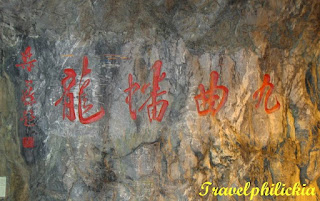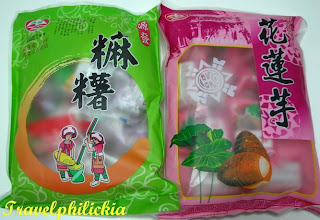Due to unavailability of HuaLien Tour Guide, Mr. Chen, we had to switch our itinerary to explore Taipei on fifth day instead, and visit HuaLien on the sixth day. For easy reference in this blog, I've arranged the itinerary of Day 5 together with the rest of the days (Day 7 and 8) in Taipei. Do click here to view the itineraries in Taipei.
Day Six
Took Metro to Taipei (臺北) train station (left photo below). Boarded an early train: 自強号1051 at 0642 hrs from Taipei (臺北) train station to HuaLien (花蓮) train station. The return tickets cost TWD 802 and were bought on the previous day (right photo below). The train arrived at HuaLien station at 0950 hrs.


Once we came out of the station, our driver cum tour guide Mr. Chen was already waiting for us. Boarded his taxi and headed to our first sight.
Taroko National Park (太魯閣國家公園)
Taroko National Park is one of the nine national parks in Taiwan and was named after the Taroko Gorge.
Local Produce
- Along the way, our tour guide stopped by one of the roadside stalls to introduce the Taiwanese maize and sweet potatoes. Nothing special about the taste except the maize was whiter than those commonly found in Singapore and the color of the sweet potatoes is purple instead (photos below).


Entrance Archway
- This was the first scenic spot we saw in Taroko National Park. Almost all visitors would take a photo at this archway (left photo below). Mist could be seen hanging on the mountain tops behind this archway (right photo below).


Eternal Spring Shrine (長春祠)
- Second scenic spot: Eternal Spring Shrine. Along the way, through a rock tunnel (left photo below) there was this hanging rock formation that resembles a "lion's head" (right photo below).


The Eternal Spring Shrine was built in the middle of a mountain slope. Visitors could walk along the Eternal spring shrine trail to reach the shrine where part of the trail is through the granite rock (photos below).




Lunch near the Entrance Archway
- As it was near lunch time, the tour guide then drove us to one of the restaurants near the Entrance Archway (just 100-metres away). Had these 'kampong' chicken and some fried squid with green pea. Couldn't remember the exact price but was quite reasonable cost for a meal.


Swallow's Mouth (燕子口)
- Third scenic spot: Swallow's Mouth. This place was named because flocks of swallows lived and nested in these holes during spring and summer period every year (photos below).


The tour guide showed us various rock formations that resemble 'head of a leopard' (left photo below), 'elephant' (right photo below), 'face of a tiger' (bottom left photo) and 'face of an Indiana chief' (bottom right photo). All these rocks are formed naturally.




According to our tour guide, the water that flows through the granite rocks is crystal clear as seen in the greenish water pond (left photo below), while water that flows through the vegetation contains mud that caused it to be milky (right photo below).


I've also captured a video using my camera of the flowing stream.
Tunnel of Nine Turns (九曲洞)
- Fourth scenic spot: Tunnel of Nine Turns. This is the most magnificent part of the Taroko Gorge, where sheer cliffs are opposite each other. Many tunnels were constructed to allow visitors to have a good view of the cliffs (photos below). Do not confuse by the word 'Nine' as this word is used commonly in Chinese expression to symbolize 'Many'.




One interesting scenery along the trail is the 'Fish leaping across the dragon gate' (鱼跃龙门), formed by Kelan river rushing through a small gap in the rocks (left photo below). Due to the effect of erosion, this fish is no longer visible. Visitors are also warned to be cautious as huge rocks could fall off from the hanging cliffs anytime! (right photo below).


Cihmu Bridge (慈母橋)
- Fifth scenic spot: Cihmu Bridge. After passing Tunnel of Nine Turns, we arrived at Cihmu Bridge, which is an H-Shape hanging bridge with marble stone lions on each end and with marble lotus stones on two sides (left photo below). The rock beneath the bridge looked like a frog. A pavilion was built on this frog-like rock which made it a crown on the frog's head (right photo below).


Tiansiang (天祥)
- Last scenic spot: Tiansiang. Tiansiang is a large river terrace recreational area (left photo below). A five-star hotel: Grand Formosa Taroko was located besides the river (right photo below). Bought a Taroko souvenir book at TWD 120 from a souvenir shop inside this hotel.


Due to time constraint and distance limitation, the tour guide could only bring us to the above mentioned spots. For more other scenic areas, click here for more information.
Chisingtan (七星潭)
Our tour guide brought us to the next HuaLien landmark: Chisingtan. Its name as a lake was misleading because it is a beach facing the open seawater. With the magnificent mountains as a background, it does make a beautiful photo. It used to be a fishing village but through local government's effort, it has become a popular tourist site. No digital enhancement was done to these photos; the seawater was the same bluish clear in color when I saw it there (photos below).




Next we went to a fishing wharf where they sell sashimi (left photo below). This plate of tuna & salmon sashimi cost only TWD 100 (right photo below).


Both the fish ball soup & bee-hoon cost only TWD 100. The sashimi was fresh and the fish balls were the best I’ve ever tasted.


Mochi Shop (麻薯)
Last stop: Yuanfa Mochi (麻薯) shop. The tour guide took us to this 70-year old Yuanfa shop for some HuaLien souvenirs (photos below). Do note that hand-made mochi has very short expiry period.


Train from HuaLien to Taipei
Our friendly tour guide Mr. Chen then drove us back to HuaLien train station (left photo below). As we had bought a later timing of return tickets, he kindly helped us to change the train timing to an earlier timing. Took train: 自強号1058 at 1800 hrs and reached Taipei station at 2100 hrs.
One interesting observation was that every train ticket comes with this small piece of 'summary' (right photo above). This summary was not a receipt, but to place in front of the seat if you do not want to be disturbed during ticket checks.


Here's the photo of Mr. Chen and his name card. The cost of this full day tour was TWD 2000, which was very reasonable. Highly recommended to anyone who wants insight exploration of HuaLien.


Ximending (西门町)
Went to Ximending again for supper, and had oyster omelette (蚵仔煎) (left photo below) and soy-braised meat rice (鲁肉饭) (right photo below). The topping of sweet gravy on the oyster omelette is rather unique in Taiwan, which is very different from those sold in Singapore.


 Posts RSS
Posts RSS


